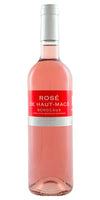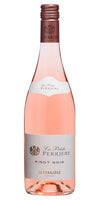Collection: Rose Wine
All products




Rose wine: the best of both worlds?
The picture-perfect rose wine is a proper crowd-pleaser! Many people consider it an ‘easy’ wine – light to drink, well-paired with any kind of meal, fairly low in calories and affordable to buy.
Although this pink wine has had its ups and downs throughout the centuries, it is widely loved and appreciated in the wine community today. So, where does the rose craze come from?
Rose has a long history as one of the first wines produced in Ancient Greece and later picking up in popularity alongside other light wine fermentations when French wines first entered the US. Back in the day, rose was considered the ‘fancier’ choice compared to red and white wine, but jumping forward to the late 1900’s, its reputation took a knock because of the overly sweet, mass-produced ‘blush wines’ that did the rounds during this period.
But like a phoenix, rose rose from the ashes in the early 2000’s when American socialites and celebrities put it back under the spotlight. Rose sales blew up – so much that 2014 famously marked the ‘rose shortage’ in the Hamptons. In the US, 2019 figures show rose wine is growing at a staggering rate of 40% per year!
The rise of the Instagram-age and the younger generation’s rose-tinted lenses popularised this wine more than ever before with over 600,000 images posted under the tag #roseallday. Rose is fun and imaginative, which is why it has become such a cultural landmark.
What is rose wine?
Let’s just get this out of the way: rose is not the result of mixing red and white wine! You’ll receive quite a few dirty looks if you bring this up in the company of wine experts.
Rose is made by lightly crushing red grapes and macerating it for a few days before extracting the juice and continuing with the fermentation process as normal. The pinkish colour comes from the red grape skins – the longer the wine ‘soaks’ in the red skin pigmentation, the darker the shade of the rose will be.
Rose is not bound to a specific geographical region and can be made from many different grape varieties, most commonly pinot noir, merlot, grenache, carignan and cinsault, to name a few. This means that the taste of rose will range widely – from flowers and citrus to honeydew and celery.
The most important producers of rose are France, Spain, Italy and the US. If you’re ever wondering which bottle to go for, you can’t go wrong with something French!
If you’re a complete beginner in the rose game, you’ll always win your dinner guests over by opting for a dry blend rather than something sweet. European rose tends to be drier than rose from other regions in the world, which is helpful to keep in mind when choosing your perfect bottle.
Something important to remember is that rose is a ‘young’ wine, meaning that – unlike red wine – it doesn’t need to mature after production and doesn’t improve over time. Rose is not a ‘collector’s wine’ and shouldn’t be saved for special occasions or left to stand in your wine rack for 20 years (luckily it won’t be a problem to finish a bottle of pink over one or two dinners!).
On that note, a plus point of rose is that you’ll find it’s often a lot cheaper than other wines, especially red, because it’s less costly to produce and can be sold immediately.
How rose wine made
Like we said, rose is not made by mixing red and white wine – the process is far more complicated than that!
In layman’s terms, rose is made when the skins of red grapes are used to stain the wine for a few hours (or days, depending on how dark the winemaker wants the finished wine to be) and removing the grape skins before the fermentation process.
There are three main methods to making rose (it’s quite the art form!):
1. Maceration: With this method, the red grape skins are left to dwell in the unfermented wine for a set amount of hours or days, followed by the fermentation process to transform the mixture into a beautiful blend of rose. This is the most traditional way to produce rose and is often referred to as the ‘skin contact’ method.
2. Saignee: Meaning ‘bleeding’ in French, this method entails a portion of the juice from red grapes being extracted to enhance the concentration of the red wine. The juice that has been ‘bled’ is then transferred into a new vat to make rose. This method is quite rare and only makes up about 10% of total rose production.
3. Blending: The least favourable of the three, this process is pretty self-explanatory, referring to the blending of red and white wine by adding a small volume of red wine to a large batch of white wine to achieve the stained pink pigmentation.
How many calories are in rose wine?
For many wine drinkers, this is always one of the first questions that come to mind when trying out a new wine.
But there’s good news! Rose is relatively low in calories and is actually the least calorie-packed compared to red and white wine. Although it will differ from wine to wine, a glass of rose on average contains 70-80 calories per 100ml, compared to 73-83 calories per 100ml in white wine and 75-85 calories per 100ml in red wine.
The best rose wines of 2019
At Popsy & JJ, we appreciate a good glass of rose. We’ve reviewed more than 2,000 wines and curated our favourites in our online shop for our fellow Australian wine lovers to enjoy. Choosing the perfect decadent dinner companion has never been this easy!
Some of our favourite pink wines include the 2018 Chateau Haut-Maco Rose and the 2018 La Perrière ‘La Petite Perrière‘ Pinot Noir Rose. Read our reviews of these winning blends and stay tuned for more rose updates!

